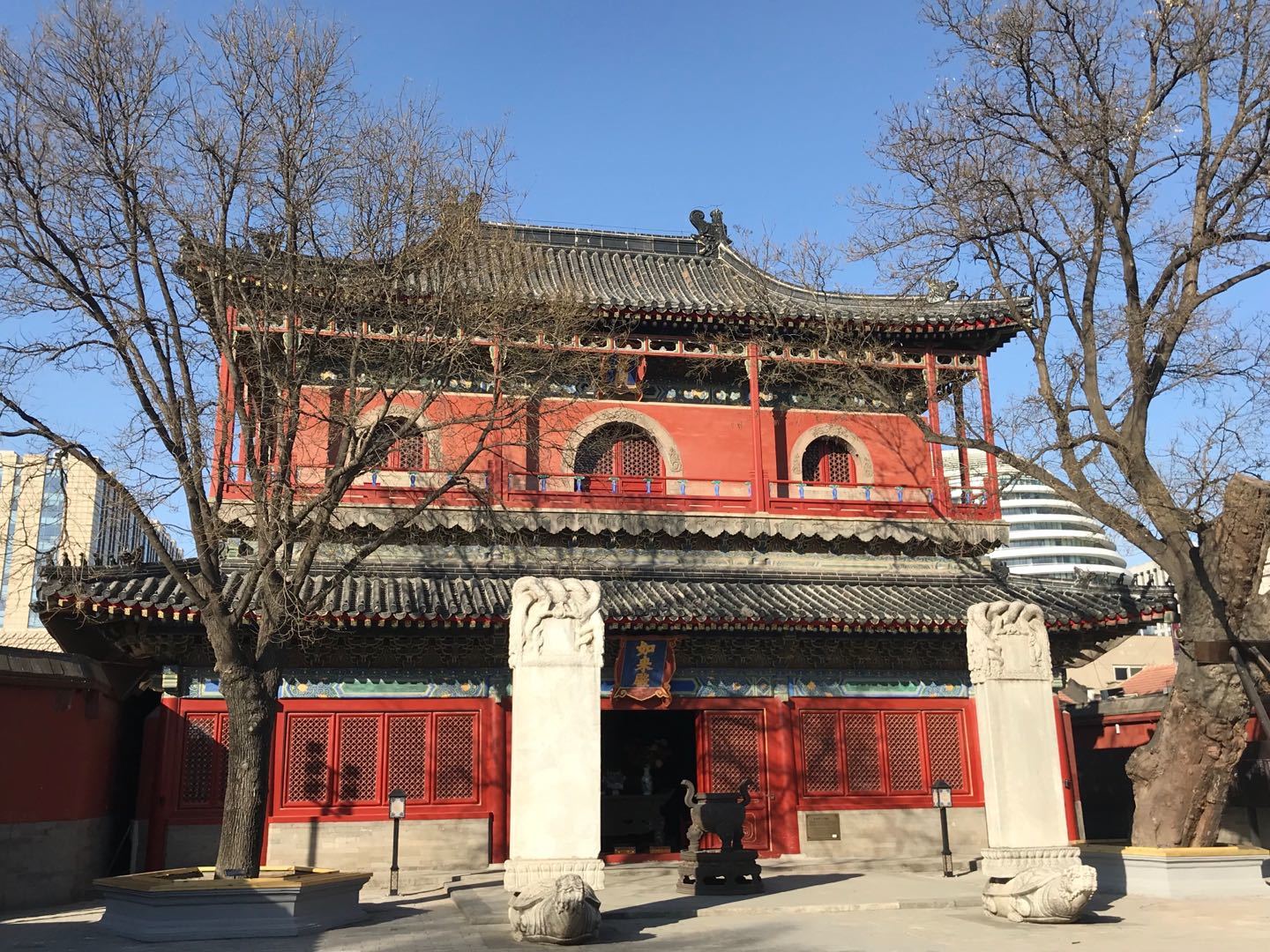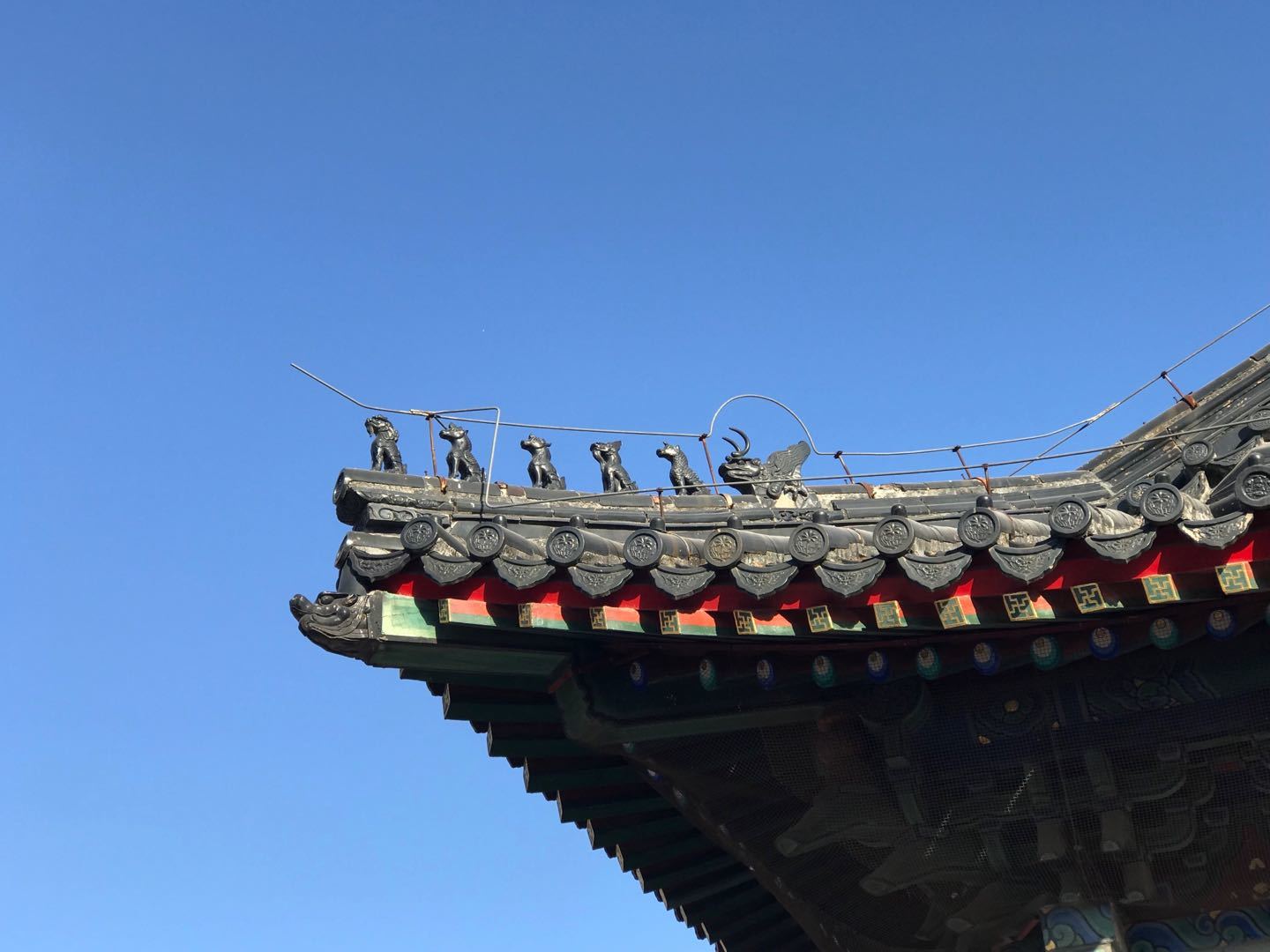智化寺位于北京市东城区禄米仓东口路北。明初太监王振于正统八年(1443年)仿唐宋“伽蓝七堂”规制而建,初为家庙,后赐名“报恩智化寺”。
智化寺坐北朝南,排列布局具有明代特点,也是北京城内现存最大的明代建筑之一,是研究明代建筑的重要实例。寺中原有房数百间,占地2公顷多,原有中路5进院落,及东跨院后庙和西跨院方丈院。该寺主要建筑自山门内依次为钟鼓楼、智化门、智化殿及东西配殿(大智殿、藏殿)、如来殿、大悲堂等。寺内主要建筑物的屋瓦用黑色琉漓脊兽铺砌,虽经历代多次修葺,梁架、斗拱、彩画等仍保持明代早期特徵。经橱、佛像及转轮藏上的雕刻,道劲古朴,艺术高超。1961年被国务院列入首批全国重点文物保护单位。
山门在智化寺最南边,砖砌仿木结构,拱券门,黑琉璃筒瓦单檐歇山顶,面阔三间,进深一间,通宽7.1米,门额上有石刻“敕赐智化寺”。山门前有石狮一对,门对面原有照壁,解放后拆除。
 山门之内为钟鼓楼,分列东西,形制相同,黑琉璃筒瓦歇山顶,面阔、进深均为7.1米,下层为拱券门,单昂三踩斗栱,上层四壁为木障日板,四出门,单昂三踩斗栱。
山门之内为钟鼓楼,分列东西,形制相同,黑琉璃筒瓦歇山顶,面阔、进深均为7.1米,下层为拱券门,单昂三踩斗栱,上层四壁为木障日板,四出门,单昂三踩斗栱。
钟鼓楼北为智化门,又称天王殿,黑琉璃筒单檐瓦歇山顶,面阔三间,进深两间,通面宽13米,进深7.8米,单昂三踩斗栱,南北均为障日板壸门式门楣,南面门楣上悬华带匾“智化门”。殿前有石碑两座,殿内原有弥勒、韦陀、金刚等塑像,现已无存。
智化殿在智化门之北,为寺院正殿,黑琉璃筒瓦歇山顶,井口天花,面阔三间,宽18米,进深14.5米,重昂五踩斗栱,殿后有灰瓦悬山卷棚顶抱厦一间。明间层顶原有金碧辉煌的斗八藻井,但在二十世纪三十年代连同万佛阁的藻井,被寺僧盗卖至美国。
智化殿前有东西配殿,东为大智殿,西为藏殿,形制相同,黑琉璃筒瓦单檐歇山顶,面阔三间,进深两间。
智化殿后有一黑琉璃瓦庑殿顶重楼,上层为万佛阁,下层为如来殿。万佛阁面阔三间,进深三间,单翘重昂七踩斗栱,上下层墙壁上遍饰佛龛,原置小佛像9000余尊,故上檐榜书万佛阁,但现佛像缺损很多。如来殿因殿内供如来而得名,面阔五间,进深三间,单昂单翘五踩斗栱,殿三面为砖壁,南面为隔扇门窗,东北、西北角有楼可上楼,现在不开放。
智化寺的佛教音乐传自明代,已经有500多年历史,一定要听一下。演奏时间是每日上午10时和下午3时。
The Zhihua Temple (智化寺) is a Ming dynasty-era Buddhist temple in Beijing. It is located in the Lumicang (禄米仓) hutong, in the Dongcheng District, within the 2# Ring to the north of Jinbaojie Street, west of the Yabaolu area. The temple was built in 1443 at the order of Wang Zhen, a powerful eunuch in the Rites Supervising Office of the court of the Zhengtong Emperor (also known as Emperor Yingzong; reigned 1436-1449 and 1457-1464).
 The temple, surrounding buildings, and grounds comprise approximately 2 hectares (4.9 acres). It is one of the most important original building complexes from the Ming dynasty period in the Old City area, and one of the only wooden structures and groups of buildings from the Ming dynasty to remain intact in Beijing. It is also striking for its extensive use of black roof tiles. The Beijing Cultural Exchange Museum, established in November 1992, is located in the temple compound; its principal aim is "as a centre for developing cultural exchange and for developing the study of cultural relics and museums."
The temple, surrounding buildings, and grounds comprise approximately 2 hectares (4.9 acres). It is one of the most important original building complexes from the Ming dynasty period in the Old City area, and one of the only wooden structures and groups of buildings from the Ming dynasty to remain intact in Beijing. It is also striking for its extensive use of black roof tiles. The Beijing Cultural Exchange Museum, established in November 1992, is located in the temple compound; its principal aim is "as a centre for developing cultural exchange and for developing the study of cultural relics and museums."
At the temple, a group of musicians regularly performs centuries-old ritual music which has been handed down over 27 generations. The six-member group is led by the octogenarian Buddhist monk Zhang Benxing (张本兴, born c. 1922), the only surviving member of the 26th generation of musicians, and the last person to have learned the music in the traditional manner. In addition to singing voices, the instruments used include guanzi (oboe), dizi (bamboo flute), sheng(mouth organ), yunluo (a set of ten small tuned gongs mounted vertically in a frame), and percussion including drums and cymbals.
Cache:
A 5ml tube only logpaper, BYOP.
Note:
Opentime:08:30-16:30,Monday close.
Ticket: 20RMB, Wednesday free.